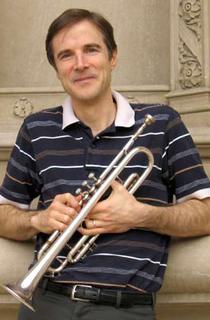Resound! Fanfares for Trumpet and Computer
I believe the real challenge is always to write and perform music that captures the imagination and carries the listener to a wonderful place. I hope these little pieces will expand what we think of as “trumpet music” and perhaps open some new pathways for composers, performers, and listeners alike
Resound! Fanfares for Trumpet and Computer was originally composed for the Pittsburgh New Music Ensemble (PNME) and premiered in the summer of 2002 at the New Hazlett Theater in Pittsburgh, Pennsylvania. The complete composition consists of seven movements, which can be performed individually as fanfares or together as an extended work. Each fanfare expands the solo trumpet into an ensemble using a different technique. To some extent, this is like a canon, where part of the enjoyment is in how the music emerges from interlocking voices. During the premier a different fanfare was performed at the beginning of each concert in PNME season. The complete work is available on Trumpet Voices: Classics for Trumpet Ensemble (Four Winds Label), recorded by Neal Berntsen.
The technical component of Resound! is software written entirely by the composer using a real-time object system named Aura. Aura provides support for communicating objects running in different threads so that expensive operations, such as graphical interface updates, do not interfere with time-critical operations, such as audio processing. All sound processing is carried out in software running under Linux with real-time extensions. Aura has become a test bed for new programming techniques for interactive systems building. In addition to the basic object system, Aura offers a graphical programming interface for dataflow-oriented audio processing and a high-level, real-time scripting language based on Python. In Resound! signal processing is manually synchronized to the human trumpet performance through cues given to a graphical interface. The processing includes time delays, pitch shifting, granular synthesis, ring modulation, looping, overdubbing, and various combinations, although each fanfare in the suite uses only a small subset of these.
No comments yet. Why not add the first?
Acknowledgements & Credits
Credits
Texts: All texts were written by the exhibition participants.
Editor: Pamela Jennings, Pittsburgh, PA (USA)
This work has been republished from the 2007 Exhibition 'Speculative Data and the Creative Imaginary: Shared Innovative Visions between Art and Technology' curated by Pamela Jennings As part of the ACM Creativity and Cognition Conference at at the National Academy of Sciences' headquarters at 2100 C St., N.W., Washington, D.C. The original exhibition catalogue can be found at: http://www.pamelajennings.org/PDF/NAS_Catalog.pdf
Exhibition Sponsors
Office of Exhibitions and Cultural Programs of the National Academy of Sciences presenting a program of exhibitions that explore relationships among the arts and sciences, engineering and medicine.
http://www7.nationalacademies.org/arts/
The 2007 Association for Computing Machinery Creativity and Cognition Conference held in Washington D.C. June 13th – 15th, 2007, exploring the theme of cultivating and sustaining creativity: understanding how to design and evaluate computational support tools, digital media, and socio-technical environments that not only empower our creative processes and abilities, but that also encourage and nurture creative mindsets and lifestyles. - http://www.cs.umd.edu/hcil/CC2007/
National Science Foundation Computer, Information Science and Engineering (CISE) Creative IT Program, exploring the synergies between creativity and information technology, science, engineering, and design research.
Copyright is held by the author/owner(s) of the text and images reproduced in this catalog

← Back to work
0 Comments